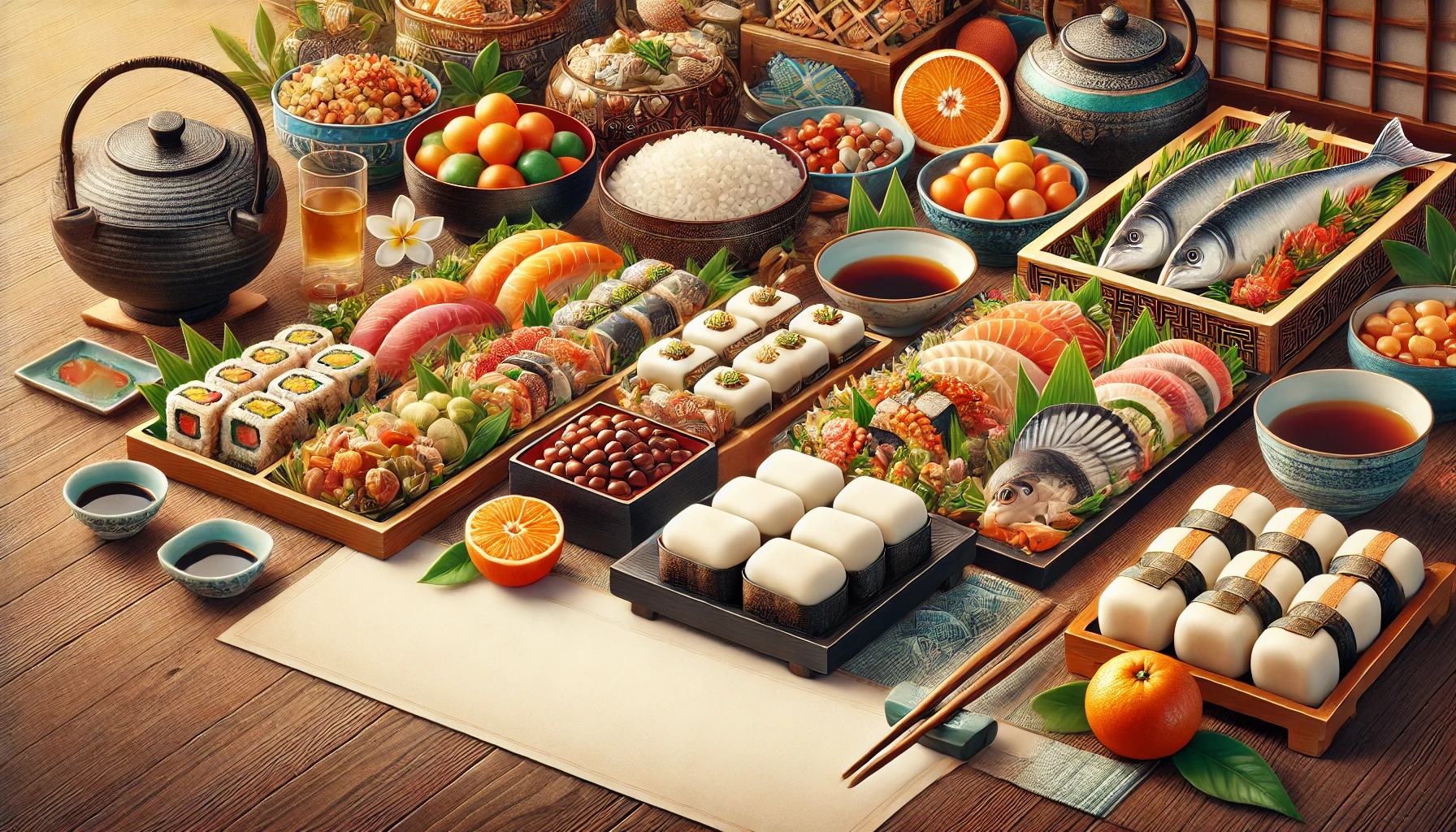Celebrating Japanese New Year: Osechi Ryori, Mochi, and Nanakusa-gayu Traditions
Celebrating Japanese New Year: Food plays an integral role in marking special occasions worldwide, and Japan is no exception. Traditional Japanese food eaten on special occasions is often tied deeply to cultural values, seasonal changes, and the hope for prosperity, health, and good fortune. From the rich spreads of Osechi ryori during New Year celebrations to the intricate rice dishes served during Girls’ Day and Boys’ Day, Japanese cuisine during festivals and milestones offers a glimpse into the country’s rich heritage.
In this blog, we’ll take a journey through the special dishes eaten during Japanese New Year celebrations, including Osechi ryori, mochi, and Nanakusa-gayu. We’ll also explore the foods enjoyed during Girls’ Day and Boys’ Day, and other unique Japanese holidays, providing a detailed look at the cultural significance of each dish.
Osechi Ryori: The Quintessential New Year Feast
When it comes to Japanese food eaten on special occasions, few spreads are as iconic as Osechi ryori. This traditional Japanese meal is enjoyed on New Year’s Day and is meant to bring good luck and prosperity in the coming year. Beautifully arranged in stacked lacquer boxes, Osechi ryori consists of several dishes, each with its own symbolic meaning.
What’s Included in Osechi Ryori?
Osechi ryori is not just a feast for the taste buds; it’s also a feast for the eyes. Each item is carefully selected for its meaning, often related to health, wealth, or fertility. Some common dishes include:
- Kuromame (sweet black beans) symbolizing health and diligence.
- Kazunoko (herring roe) representing fertility.
- Datemaki (sweet rolled omelet) symbolizing learning and wisdom.
These dishes, and many more, make Osechi ryori a key part of the New Year celebrations in Japan.
Mochi for New Year: Symbolism in Every Bite
Mochi plays a central role in Japanese New Year traditions. These soft rice cakes, made from glutinous rice, are enjoyed in various forms during the New Year celebrations, especially in dishes like ozoni, a soup containing mochi, vegetables, and sometimes chicken.
The Tradition of Kagami Mochi
One of the most well-known customs is the display of Kagami mochi, which consists of two round mochi stacked on top of each other, often topped with a mandarin orange. This arrangement represents the past and present, with the hope of prosperity for the future. Mochi is not just eaten for its delicious texture; it holds deep significance for ensuring longevity and good fortune.
Nanakusa-gayu: A Healthy Start to the Year
On January 7th, many Japanese households prepare Nanakusa-gayu, or “Seven Herb Rice Porridge,” a dish designed to promote health after the indulgent eating that accompanies New Year celebrations. This tradition dates back to the Heian period and is intended to provide a fresh, healthy start to the year.
What’s in Nanakusa-gayu?
Nanakusa-gayu is made from seven specific herbs: water dropwort, shepherd’s purse, cudweed, chickweed, nipplewort, turnip, and radish. These herbs are believed to have medicinal properties and are thought to protect the body from illness. This simple rice porridge, eaten in the first week of the year, provides balance after the richness of Osechi ryori and other festive meals.
Chirashi-zushi and Hina-arare: Special Foods for Girls’ Day
Another major holiday in Japan is Hinamatsuri, or Girls’ Day, celebrated on March 3rd. During this festival, families pray for the health and happiness of their daughters, and as with many Japanese celebrations, food plays a vital role.
Chirashi-zushi: A Feast for the Eyes and Palate
Chirashi-zushi is a traditional dish enjoyed during Girls’ Day. It is a colorful bowl of sushi rice topped with ingredients like shrimp, vegetables, egg, and sashimi. The vibrant colors of Chirashi-zushi represent prosperity and happiness, making it the perfect dish for celebrating young girls.
Hina-arare: The Delightful Crunch of Rice Crackers
Another treat associated with Hinamatsuri is Hina-arare, small, brightly colored rice crackers that are sweet and salty. These crackers symbolize the hope for good weather and health in the coming year.
Kashiwa-mochi and Chimaki: Celebrating Boys’ Day
Just as Hinamatsuri celebrates girls, Kodomo no Hi (Boys’ Day) celebrates boys on May 5th. Foods eaten on this day are meant to encourage strength and resilience.
Kashiwa-mochi: Symbolism Wrapped in a Leaf
Kashiwa-mochi is a rice cake filled with sweet red bean paste and wrapped in an oak leaf. The oak leaf represents strength and endurance, making Kashiwa-mochi an appropriate treat for Boys’ Day, symbolizing the hope that boys will grow into strong, capable men.
Chimaki: Sticky Rice for Prosperity
Another traditional food for Boys’ Day is Chimaki, sticky rice wrapped in bamboo leaves. Similar to Kashiwa-mochi, Chimaki symbolizes protection and good fortune. Eating Chimaki is believed to ward off evil and bring success.
Eho-maki: The Lucky Sushi Roll for Setsubun
Setsubun, the “bean-throwing” festival, marks the end of winter and the beginning of spring in Japan. As part of this celebration, people eat Eho-maki, a long, uncut sushi roll that is believed to bring good luck if eaten while facing a specific direction, which changes every year based on the Chinese zodiac.
What’s Inside Eho-maki?
Eho-maki is traditionally filled with seven ingredients, each symbolizing good fortune. Common fillings include tamagoyaki (Japanese omelet), kanpyo (dried gourd), and cucumber. The seven ingredients are believed to bring luck in various aspects of life, from health to wealth.
Unagi Kabayaki and Sekihan: Celebrating with Traditional Dishes
Other Japanese foods eaten on special occasions include Unagi kabayaki and Sekihan, dishes that are not limited to a single holiday but are enjoyed during significant milestones or auspicious days.
Unagi Kabayaki: Grilled Eel for Day of the Ox
Unagi kabayaki, grilled eel with a sweet soy glaze, is traditionally eaten during the summer months, particularly on the Day of the Ox (Doyo no Ushi no Hi). Unagi is believed to provide stamina and strength, which is essential during the hot summer.
Sekihan: A Festive Dish for Celebrations
Sekihan, a dish made from red rice and adzuki beans, is typically served at weddings, birthdays, and other joyous occasions. The red color of the rice is symbolic of happiness and is believed to ward off evil spirits. This simple but meaningful dish has been a part of Japanese celebrations for centuries (AdTargeting).
The Cultural Significance of Japanese Foods on Special Occasions
From Osechi ryori and mochi during New Year’s to Eho-maki and Sekihan for other festivals, traditional Japanese food eaten on special occasions reflects the country’s deep connection to its history, seasons, and values. Each dish tells a story, symbolizing hope, health, prosperity, and protection.
Whether it’s Chirashi-zushi for Girls’ Day or Kashiwa-mochi for Boys’ Day, the foods enjoyed during these celebrations offer more than just sustenance—they provide a way for families to come together and honor their traditions.
For more insights into Japanese culture and the significance of traditional foods, explore additional resources at Regent Studies.




